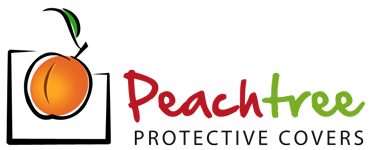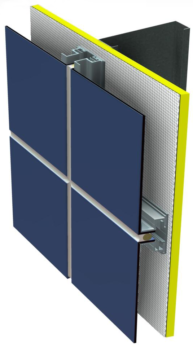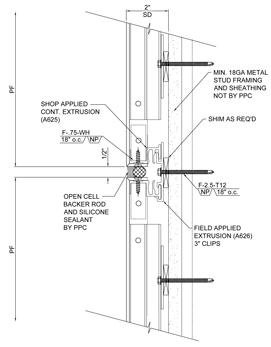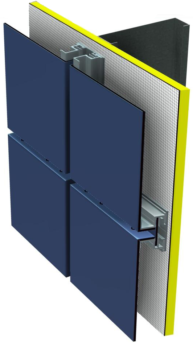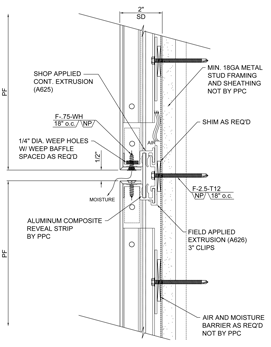Quicklinks
Peachtree Protective Covers offers a turn key solution to our customers through engineering/design, fabrication, and installation of metal wall panel systems. Peachtree Protective Covers is proud to be an authorized dealer for Centria modular metal panel systems. Centria manufactures high performance building envelope systems designed to provide superior protection against the elements. These systems include the roof, exterior walls, foundation and fenestration system. They’re designed to prevent air, water, heat, light and noise from entering the building, increasing the durability of the building’s structure and improving indoor comfort.
MCM – Metal Composite Material
Exposed Sealant System (ES-600)
| SYSTEM CHARACTERISTICS | |
| Joint Type: | Silicone sealant and backer rod |
| Joint Size: | 3/8″-5/8″ (1/2″ standard) |
| Testing: |
ASTM E283 (Air penetration testing) ASTM E330 (Structural performance testing) ASTM E331 (Water penetration testing) |
| Cost Factor: | Most economical MCM Panel system |
The ES-600 is a proven rout and return exposed sealant (wet joint) system that provides an airtight and watertight barrier for exterior cladding. The ES-600 system utilizes a continuous extrusion at the perimeter of the panel with an attachment extrusion that allows for thermal as well as seismic movement without buckling/oil-canning of the panels or joint failure.
Rain Screen System (RS-610)
| SYSTEM CHARACTERISTICS | |
| Joint Type: | MCM Spline reveal |
| Joint Size: | 1/2″; 3/4″; 1″ (1/2″ standard) |
| Testing: |
ASTM E283 (Air penetration testing) ASTM E330 (Structural performance testing) ASTM E331 (Water penetration testing) |
| Cost Factor: | Most economical dry joint system |
The RS-610 is a proven rout and return rainscreen (dry joint) system that when used in combination with a properly designed and installed air and water barrier, provides a wall assembly that will meet standard air and water penetration requirements. The RS-610 system utilizes a continuous extrusion at the perimeter of the panel with an attachment extrusion that allows for thermal as well as seismic movement without buckling/oil-canning of the panels or joint failure. Pockets within the continuous perimeter extrusions receive reveal strips that fill the ½” gap between panels. This reveal strip can be supplied in matching or contrasting colors.
Color Charts
Specifications
Section 07 42 13.23 – MCM – Rainscreen Attachment System – View Specification
Section 07 42 13.23 – MCM – Exposed Sealant Attachment System – View Specification
Many factors influence the cost and usefulness of MCM panel systems. Following the process outlined below will help to ensure an efficient system.
UNDERSTAND THE COST ASSOCIATED WITH YOUR SELECTED FINISH
Choosing a manufactures standard finish provides the least expensive option. Pricing will vary between manufacturer’s standard solid color, mica finishes and metallic finishes. Solid colors are the least expensive and natural metal finishes are the most expensive.
Custom colors are available, but set up costs and premium price will be required for projects with less than 10,000 square footage of an exposed panel areas with the selected custom color. Pricing for custom colors on a large project is very comparable to standard finishes.
PANEL MODULAR SIZES
MCM panels can be fabricated in many custom sizes. When designing wall panels, consider the manufacturer’s standard widths are 50” and 62”. For best use of materials, panels should be designed around a standard modular size of 48” or 60” width – utilizing the 50” and 62” materials with 1” route and return legs. The width of panels detailed can affect the yield of finished materials from the stock materials – increasing the amount of “drop” materials and the price per square foot for finished product.
Additionally, larger panels sizes allow for a lower price per SF. From a panel fabrication perspective, a similar amount of shop labor is required to fabricate panels regardless of size. Additionally, smaller panels require more extrusions than larger panels (a project with mostly 2’ x 2’ panels will require 2x more extrusions than a project with mostly 4’ x 4’ panels and 4x more extrusion than a project with mostly 4’ x 8’ panels.
CURVED VS FLAT PANELS
MCM panels can be fabricated into many various geometric shapes – including curved panels. Pricing of MCM wall panels is affected by the complexity of the panel shape; flat wall panels are more economical than multifaceted panels, and curved wall panels are most expensive. Additionally, MCM panels have a minimum radius of 9”.
PANEL CORE AND THICKNESS
4mm materials are more economical that 6mm. PE/Standard (Polyethylene) core is more economical than FR/Fire Retardant core materials. Consult the building code to make sure the appropriate materials are specified. As a rule of thumb, MCM materials over 40’ from grade will require FR core materials.
PANEL SYSTEMS
There are several different MCM panel systems available, in order of least expensive to most expensive:
- Exposed Sealant System
- Exposed Fastener Face Fastened System
- Rainscreen – Dry joint reveal system
- Pressure-Equalized Rainscreen System
ASK FOR ASSISTANCE
PPC is ready to provide expert guidance at any stage of the planning process. Call us direct at (800) 341-3325 or email us.
